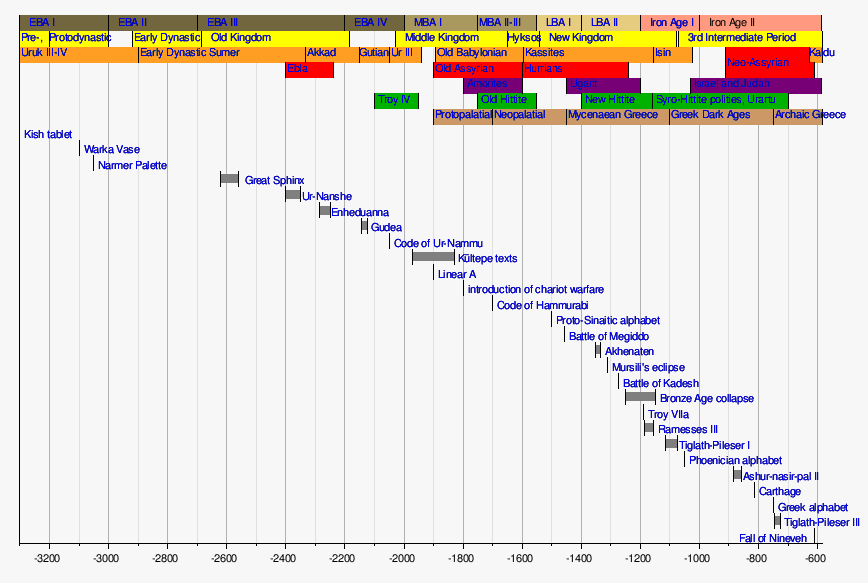Puabi
Puabi (Akkadian: "Word of my father"), also called Shubad due to a misinterpretation by Sir Charles Leonard Woolley, was an important person in the Sumerian city of Ur, during the First Dynasty of Ur (ca. 2600 BC). Commonly labeled as a "queen", her status is somewhat in dispute. Several cylinder seals in her tomb identify her by the title "nin" or "eresh", a Sumerian word which can denote a queen or a priestess. The fact that Puabi, herself a Semitic Akkadian, was an important figure among Sumerians, indicates a high degree of cultural exchange and influence between the ancient Sumerians and their Semitic neighbors.
Tomb of Puabi
British archaeologist Leonard Woolley[1] discovered the tomb of Puabi, which was excavated by his team along with some 1800 other graves at the "Royal Cemetery of Ur" between 1922 and 1934. Puabi's tomb was clearly unique among the other excavations; not only because of the large amount of high quality and well-preserved grave goods, but also because her tomb had been untouched by looters through the millennia. The amount of grave goods that Woolley uncovered in Puabi's tomb was staggering: a magnificent, heavy, golden headdress made of golden leaves, rings, and plates; a superb lyre (see Lyres of Ur), complete with the golden and lapis-lazuli encrusted bearded bulls head; a profusion of gold tableware; golden, carnelian, and lapis lazuli cylindrical beads for extravagant necklaces and belts; a chariot adorned with lioness' heads in silver, and an abundance of silver, lapis lazuli, and golden rings and bracelets.
_(14580924750).jpg)
She was also buried with 52 attendants — retainers who had been suspected by excavator Leonard Woolley to have poisoned themselves (or had been poisoned by others) to serve their mistress in the next world. Recent evidence derived from CAT scans through the University of Pennsylvania Museum suggests that some of the sacrifices were likely violent and caused by blunt force trauma. A pointed, weighted tool could explain the shatter patterns on the skulls that resulted in death, while a small hammer-like tool has also been found retrieved and catalogued by Woolley during his original excavation. The size and weight fit the damage sustained by the two bodies examined by Aubrey Baadsgaard, PhD candidate at the University of Pennsylvania. Cinnabar, or mercury vapour residue was observed as well, and it would have been utilized to prevent or slow the decomposition of the bodies for the necessary funerary rites.[2]
_(14767595615).jpg)
Italian archaeologist Massimo Vidale contends that although the blunt force trauma hypothesis is plausible, the causes of death may have also been throat cutting or, as previously thought, poisoning. Unfortunately the age and state of the remains complicates the process of examining them. Almost all of the remains are flattened and shattered by the layers of dirt in which they had been buried. Woolley's practice of pouring plaster to encompass skeletal remains has provided skeletons frozen in dried plaster, and modern imaging technology provides the opportunity to reconstruct and visualize the skulls as they would have been post-mortem prior to the damage caused by millennia of decay. Although there is still some debate on the precise causes and mechanisms of death, as well as the social implications of such practices, post-mortem dressing and arrangement of the corpses has been noted by several scholars. The bodies had been contorted into unnatural positions to imitate lying on each other's laps peacefully, sometimes oriented to hide parts of the skulls that could show damage or trauma.[3] In addition, helmets and intricate headdresses had been placed on the heads, suggesting that the victims may have been killed outside the tombs, dressed, laid out, and after intricate ceremonies for Puabi, finally buried.
Remains
Puabi's skull was almost destroyed and her physical remains are kept in the Natural History Museum, London.[4] The excavated treasures from Woolley's expedition were divided between the British Museum in London, the University of Pennsylvania Museum in Philadelphia, Pennsylvania and the National Museum in Baghdad. Several pieces of the treasure were looted from the National Museum in the aftermath of the Second Gulf War in 2003. Recently, several of the more spectacular pieces from Puabi's grave have been the feature of a highly successful Art and History Museum tour through the United Kingdom and America.
References
- ↑ Wooley, Leonard (1934). Ur Excavations II, The Royal Cemetery. London-Philadelphia. p. 73 & ss.
- ↑ Baadsgaard, A., Monge, J., Cox, S., & Zettler, R. L. (2012). Bludgeoned, Burned, and Beautified: Reevaluating Mortuary Practices in the Royal Cemetery of Ur. Sacred killing: the archaeology of sacrifice in the ancient Near East (pp. 125-158). Winona Lake, Ind.: Eisenbrauns.
- ↑ Vidale, M. (2011). PG 1237, Royal Cemetery of Ur: Patterns in Death. Cambridge Archaeological Journal, 21(3), 427 - 451.
- ↑ Jennifer Y. Chi, Pedro Azara. From Ancient to Modern: Archaeology and Aesthetics. p. 51.
- "Shub-Ad of Ur". Dinner party Database. Brooklyn Museum. 2007-01-29. Retrieved 2009-09-27.
- White, Anne Terry (1941). Lost worlds: Adventures in Archaeology. Random House. pp. 300–303.
- Woolley, Sir Leonard (1950). Ur of the Chaldees: a Record of Seven Years of Excavation (Edition: 2 ed.). Penguin Books.
External links
- Queen Puabi (Penn Museum)
- Plan of Queen Puabi's gravesite.
- Royal Tombs of Ur at the University of Pennsylvania Museum
